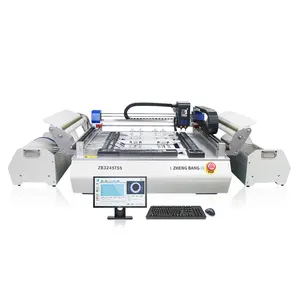Introduction to Chip Test Machines
The realm of electronics manufacturing is incomplete without the mention of chip test machines. These sophisticated devices play a pivotal role in the quality assurance of electronic components, ensuring that each chip functions as intended before being deployed in various gadgets. The semiconductor testing equipment is a cornerstone in the production of electronic motherboards, LED lights, cameras, and a plethora of household electronic devices.
Types and Applications
Chip testing equipment comes in various forms, each tailored to a specific stage in the electronics manufacturing process. From machines dedicated to PCB fabrication to those designed for intricate soldering tasks, the spectrum of machinery is broad. Applications of these machines span across the production of integrated circuits, with specialized versions like automatic test equipment for high-volume testing and wafer probers for semiconductor wafer testing.
Features and Materials
The construction of chip test machines involves precision engineering and the use of durable materials capable of withstanding the rigors of continuous operation. Features such as adjustable spraying ranges in flux systems, transport systems accommodating various PCB sizes, and control interfaces for precise operation parameters are integral. Materials typically include high-grade metals and composites that ensure longevity and reliability of the test and measurement equipment.
Advantages of Modern Chip Test Machines
Modern chip test machines offer a multitude of advantages. They enhance production efficiency through automation, allowing for a substantial output in a relatively short time frame. The precision of electronic test equipment ensures high accuracy in chip placement and soldering, which is crucial for the functionality of the final product. Additionally, the integration of various testing units within a single machine streamlines the manufacturing process, reducing the need for multiple pieces of equipment.
Selection Considerations
When selecting a chip test machine, it is essential to consider the machine's capabilities, size, and weight to ensure it meets the specific needs of the production line. Factors such as the speed of chip placement, which can range significantly between machines, and the adaptability to different PCB sizes, are critical for operational efficiency. Prospective buyers should assess the features of each machine, such as the heating, cleaning, cooling, and nitrogen protection systems, to find the most suitable semiconductor testing equipment for their requirements.
Conclusion
In conclusion, chip test machines are indispensable in the electronics manufacturing industry. With a comprehensive understanding of the types, applications, features, materials, and advantages of these machines, businesses can make informed decisions to enhance their production capabilities. For those looking to procure such machinery, exploring the diverse options available on a global B2B marketplace can lead to finding the right equipment that aligns with their manufacturing objectives.





































 浙公网安备 33010002000092号
浙公网安备 33010002000092号 浙B2-20120091-4
浙B2-20120091-4